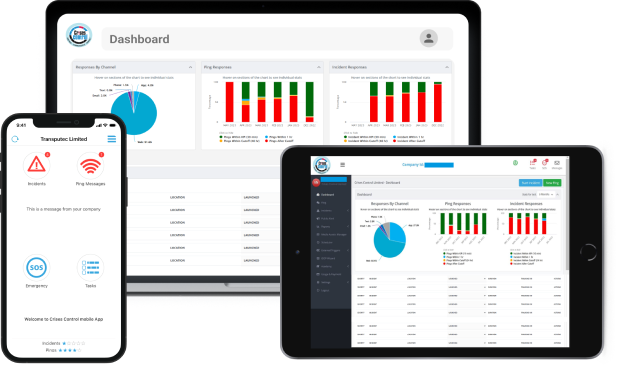Written by Anneri Fourie | Marketing Executive
Mass Notification Systems have become much more than simple alert mechanisms—they’re now essential tools that keep businesses running smoothly during crises. With disruptions ranging from natural disasters to cyberattacks, companies in the USA and Canada need communication solutions that go beyond basic alerting.
In this blog, we’ll dive into the modern capabilities of Mass Notification Systems, focusing on features like two-way communication, integration with existing systems, and advanced analytics. We’ll also explore how Crises Control helps businesses stay resilient in the face of challenges.
The Expanding Role of Mass Notification Systems in North American Business Continuity
Mass Notification Systems have evolved into sophisticated platforms that enable real-time communication, coordination, and decision-making during disruptions. This evolution is especially crucial for businesses in North America, where natural disasters like hurricanes, ice storms, and wildfires, along with increasing cyber threats, are significant challenges.
Why Advanced Mass Notification Systems are Essential for North American Businesses
- Growing Complexity of Disruptions: Whether it’s a hurricane in Florida or an ice storm in Ontario, businesses face a range of threats that demand quick, coordinated responses. Basic alert systems aren’t enough anymore. Companies need tools that provide real-time updates, enable feedback, and help teams make faster decisions during emergencies.
- Keeping Employees Safe and Informed: Safety is a top priority during any crisis. Modern Mass Notification Systems not only send alerts, but also track responses, ensuring everyone is accounted for and safe. This feature is crucial when every second counts, like during an active shooter incident or a sudden evacuation.
- Meeting Compliance and Regulatory Standards: In highly regulated industries like finance, healthcare, and manufacturing, keeping a clear record of all communications during an emergency is not just a good practice—it’s often a legal requirement. Mass Notification Systems help businesses document every step, meeting compliance needs and ensuring no one is left uninformed.
Two-Way Communication: Enhancing Crisis Response with Mass Notification Systems
One of the standout features of advanced Mass Notification Systems is two-way communication. Unlike traditional systems that only broadcast alerts, two-way communication allows businesses to receive feedback, confirm safety, and gather critical information in real time.
The Value of Two-Way Communication
- Real-Time Feedback: Imagine being able to check in with employees, confirm their safety, or gather on-the-ground insights during a crisis. This real-time feedback helps you understand the situation better and adapt your response quickly.
- Better Coordination: During a crisis, teams need to stay connected. Two-way communication allows staff to update each other about evolving situations, making sure everyone is on the same page and response actions are coordinated.
- Situational Awareness: By gathering insights from those directly affected, managers can make more informed decisions, adjust plans on the fly, and direct resources to where they’re needed most.
How Crises Control Takes Two-Way Communication Further
Crises Control’s platform excels in two-way communication, providing secure channels, like SMS, Email, Phone Calls and Push Notifications, that allow for instant feedback. Features like the SOS Panic Button empower employees to quickly notify their status or request help, creating a direct line to crisis managers. This instant loop of communication doesn’t just improve response times—it builds trust, knowing that every alert sent and every response received is valued.
Seamless Integration: Making Mass Notification Systems a Part of Your Business Ecosystem
A Mass Notification System is only as effective as its ability to integrate with other business tools. The real power comes when these systems work in harmony with HR platforms, IoT devices, security systems, and more, transforming them into central hubs for crisis management.
Benefits of Integration in Mass Notification Systems
- Automated Alerts and Responses: Integration allows alerts to be automatically triggered by other systems, such as fire alarms or security breaches, without needing manual intervention. This automated response can save valuable time during a crisis.
- Unified Command and Control: Integration means all communications are centralised, allowing for a single command centre to manage alerts, track responses, and monitor situations in real time across different platforms.
- Up-to-Date Contact Information: Integration with HR systems ensures that contact lists are always current, even as teams change or grow. This ensures that alerts reach the right people without delays.
How Crises Control Streamlines Integration
Crises Control offers robust integration capabilities, with APIs that connect its Mass Notification System to your existing business tools. This means alerts can be sent automatically when an event occurs, significantly reducing response times and streamlining emergency management. For example, connecting the system with your HR platform ensures that your contact lists are always accurate and up-to-date, so no one is left out during an alert.
Analytics and Reporting: Turning Data into Actionable Insights
One of the most powerful yet underutilised features of Mass Notification Systems is their ability to generate data-driven insights. The analytics and reporting functions provide a detailed look at how well your communication strategies perform during crises, offering valuable lessons for future improvements.
How Analytics Add Value to Mass Notification Systems
- Performance Evaluation: After any crisis, it’s essential to evaluate how effectively your communications worked. Analytics provide clear data on what went well and what needs improvement, helping you refine your strategies.
- Compliance and Documentation: In regulated industries, keeping a detailed record of all communications during an emergency is crucial. Analytics provide a clear audit trail that shows every alert sent and every response received, helping you meet legal and industry standards.
- Continuous Improvement: The insights gained from analytics allow businesses to improve their crisis management plans continuously. Each incident becomes a learning opportunity to enhance the next response.
Crises Control’s Advanced Analytics for Business Continuity
Crises Control provides powerful analytics and reporting features that give you a clear view of your communication performance. With customisable dashboards, you can monitor metrics such as message delivery rates, response times, and user engagement—all in real time. These insights help you make informed decisions during a crisis and improve your overall resilience.
Real-World Applications: How Mass Notification Systems Keep Businesses Running
To fully understand the impact of Mass Notification Systems, let’s look at some scenarios where these systems could play a crucial role in maintaining business continuity:
- Industrial Facility Emergency in the USA: Imagine a chemical spill at an industrial facility in Texas. A Mass Notification System instantly alerts all employees and safety teams, providing clear instructions on evacuation routes and safety protocols. Through two-way communication, staff can report their status, and management can quickly confirm everyone is safe and accounted for. This rapid response helps minimise potential harm and ensures that all personnel are aware of the steps needed to control the situation.
- Winter Storm Response in Canada: During a severe winter storm in Quebec, a logistics company uses its Mass Notification System to keep drivers informed about road conditions, closures, and safe routes. Real-time alerts and feedback help the company reroute deliveries, avoiding dangerous areas and ensuring that drivers remain safe while minimising disruptions to the supply chain. The system’s ability to send timely updates allows the company to maintain service levels and protect its employees during adverse weather conditions.
- Cybersecurity Threat in a North American Tech Firm: A North American tech company faces a cybersecurity threat when suspicious activity is detected on its network. The Mass Notification System quickly sends alerts to the IT team and senior management, outlining the nature of the threat and immediate actions required. This swift communication helps isolate the affected systems, preventing the spread of the cyberattack, and provides regular updates to keep all stakeholders informed. By maintaining clear lines of communication, the company is able to respond promptly and protect its data, minimising the impact on operations.
Crises Control’s Impact
Crises Control has supported businesses across North America in managing a variety of complex emergencies. Whether it’s coordinating communication during a natural disaster, guiding employees through a critical incident, or handling cyber threats, Crises Control’s Mass Notification System goes beyond basic alerting. It provides a comprehensive communication solution that helps organisations stay resilient, maintain business continuity, and protect their people and assets when it matters most.
Conclusion: Strengthen Your Business Continuity with Crises Control’s Mass Notification System
Mass Notification Systems are no longer optional—they’re a must-have for any business serious about safeguarding its people, assets, and operations. By leveraging advanced features like two-way communication, seamless integration, and robust analytics, businesses across North America can improve their crisis response and overall resilience.
Ready to see how Crises Control’s Mass Notification System can help your business stay strong during disruptions? Contact us for a free personalised demo and discover how our platform can keep your organisation resilient in the face of any challenge.
Request a FREE Demo

